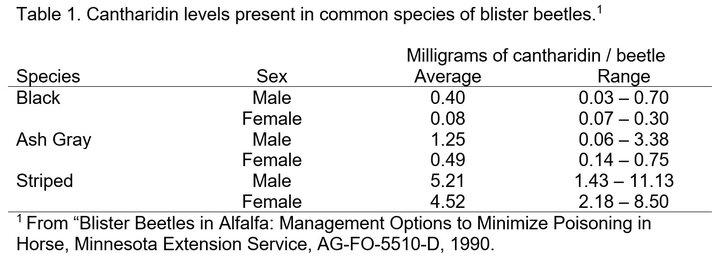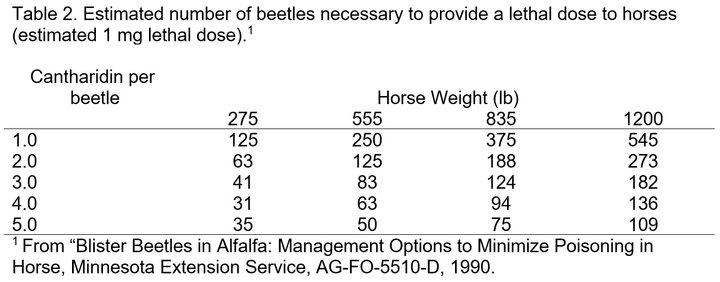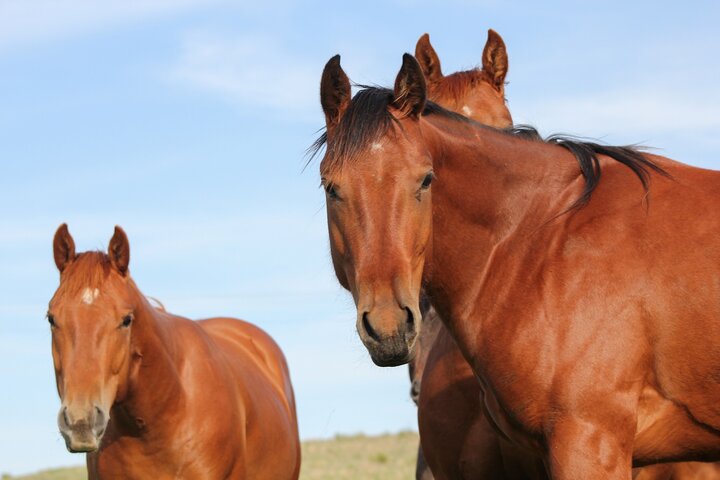Blister beetles, from the family Meloidae, are sometimes referred to as oil beetles and found in all parts of the Unites States and Canada. Adult blister beetles vary in size and color but are recognized by the elongated, narrow, cylindrical, and soft bodies. In Nebraska, the three-striped, grey, and black blister beetles (Fig. 1) are the most common species. Blister beetles produce a chemical called cantharidin which is toxic to animals and humans. The male blister beetle secretes cantharidin and presents it to the female after mating. The female beetle applies the chemical to her eggs to protect them from predators.
Biology and Habits
Most blister beetle species produce one generation per year. Female blister beetles deposit clusters of eggs in the soil in late summer. Eggs hatch in about 12 days, develop into active larvae and quickly start searching for grasshopper egg pods buried in the soil. Once egg pods are found, blister beetle larvae cease searching and begin to feed. As grasshopper egg predators they are considered beneficial. Over the course of a month larvae develop into the overwintering stage. The following spring, as temperature and moisture increases they enter the pupal stage from which the adults emerge. Adult blister beetles can generally be found in alfalfa through the second and third cuttings and in some years into the fourth cutting.
Damage
Blister beetles do not usually impact alfalfa and other plants. The major impact of blister beetles is the potential injury to horses (or less commonly to cattle and sheep) if they ingest blister beetles with harvested forage (Ray et al. 1989) (Gayle et al. 1981). After emergence, blister beetles are strongly attracted to alfalfa and weeds (e.g. goldenrod) during bloom, and feed on nectar and pollen. Beetle numbers can increase significantly, with the three striped blister beetle tending to congregate in swarms. High numbers in alfalfa or other hay crops should concern producers and horse owners because of the potentially large amounts of cantharidin contained in these congregations.
Cantharidrin is a colorless fatty substance of the terpenoid class that blisters skin tissue upon contact. Horses are very susceptible to blister beetle poisoning. A horse’s digestive tract can be severely irritated, leading to secondary infections and bleeding (Bauernfeind and Breeden 1984). Cantharidin is excreted through the kidneys, irritating the kidneys, ureter, bladder and urethra. The substance also lowers serum calcium levels and causes damage to heart muscle tissue. Animals can die within 72 hours, so it is important to contact a veterinarian as soon as blister beetle poisoning is suspected.
Toxicity to horses has not been definitely determined, but estimated minimum lethal dose is 1 milligram of cantharidin per 2.2 lb of horse body weight. The number of beetles necessary to provide a lethal dose depends on the species of beetle and how much cantharidin it retains. Table 1 provides data on three of the most common blister beetles in Nebraska. Please note male blister beetles have a higher concentration of cantharidin than females, especially the Striped Blister Beetle, a very common species in Nebraska. Table 2 provides data on lethal doses of cantharidin depending upon the amount in the beetle and the weight of the horse.


Clinical signs of cantharidin poisoning may include blisters and ulcers in the mouth, gastritis, colic, diarrhea and bloody feces. Another sign includes frequent attempts to urinate, but voiding little urine and blood in the urine. Poisoned horses may place their muzzle in water without drinking. Oral and intestinal ulcerations may be observed in cattle and sheep. Again, if cantharidin poisoning is suspected, consult a veterinarian.
Reducing Impact of Blister Beetles
Reducing the chance of blister beetle poisoning requires focused scouting and good management practices. A significant step is to harvest hay/alfalfa before flowering of alfalfa and weeds which attracts beetles to the fields. Cutting hay before 5 percent bloom reduces the risk of blister beetle contamination. Commonly, blister beetles are found within field borders, unless there is a population of flowering weeds in the field. Scout for blister beetle activity two to three days prior to harvest. If sizeable beetle populations are discovered, producers should not harvest until beetles have moved out of the field. Research has shown that dead blister beetles contain toxic levels of cantharidin, so applying an insecticide treatment is not recommended. Dead beetles in the field could be incorporated into the hay during harvest and animals might be poisoned by ingesting beetles in cured hay. Since many species of blister beetles feed on grasshopper egg pods, hay fields adjacent to rangeland may have a greater risk of blister beetle infestations.
Hay harvesting methods can impact chances of cantharidin poisoning. Crimping and conditioning hay crushes and retains beetles that get incorporated into the hay. If hay is cut with a sickle bar or rotary mower and not crimped, beetles can leave the area after hay is cut.
If beetle numbers need to be controlled prior to harvest, read the product label, and determine the harvest restriction intervals. Insecticides approved for use on alfalfa can be found at https://entomology.unl.edu/extension/crops/alfalfa. Again, please note dead beetles, still contain cantharidin and could be incorporated into the harvested product.
In Nebraska, the first cutting of hay usually occurs before blister beetles are present making it reasonable safe for horses. Hay harvested before mid-May or after early September is less likely to have blister beetles present.

References
Bauernfeind, R. J., and L. D. Breeden. 1984. Blister beetles. Kansas State University Extension Service AgFacts Entomology. 111. 4pp.
Gayle, L. G., J. C. Reagor, A. Ray and E. M. Bailey. 1981. Cantharidin poisoning in cattle. American Veterinary medical Association 118th Annual Meeting. 1997.
Ray, A. c., A. L. Kyle, M. J. Murphy and J. C. Reagor. 1989. Etiologic agents, incidence and improved diagnostic methods of cantharidin toxicosis in horses. American Journal of Veterinary Research 50, 187-191.
Management of Blister Beetles in Alfalfa, J. B. Campbell and Steve Ensley, University of Nebraska, NebFacts NF551. August 2002.
Management of Blister Beetles in Alfalfa, by J. B. Campbell, University of Nebraska, NebGuide G1645, September 2006.
Interviews with the authors of BeefWatch newsletter articles become available throughout the month of publication and are accessible at https://go.unl.edu/podcast.

